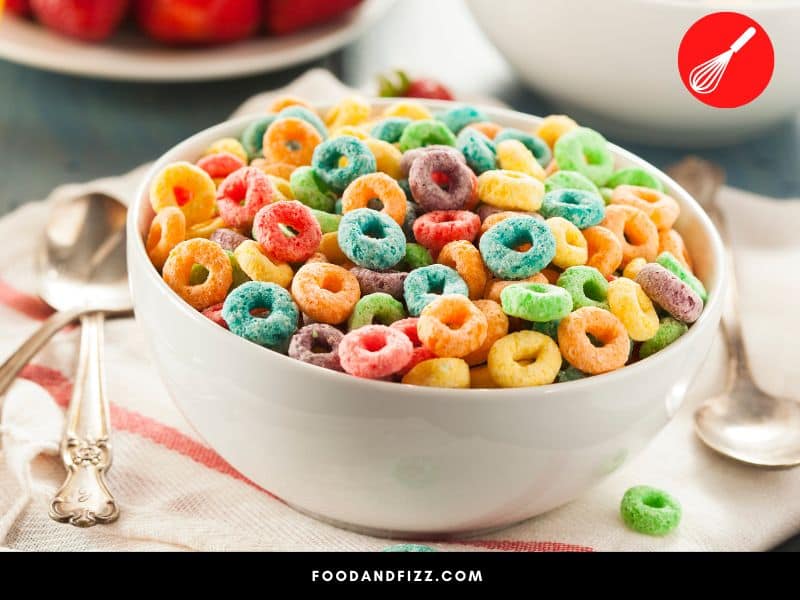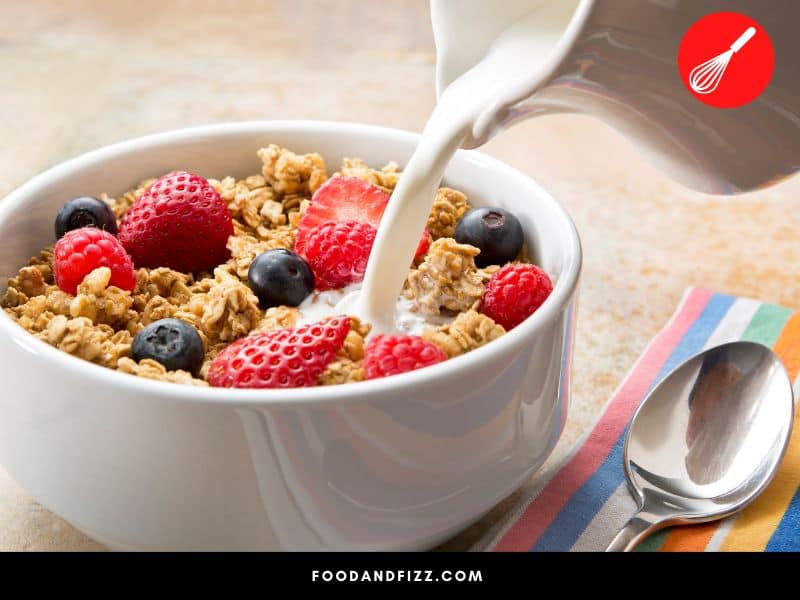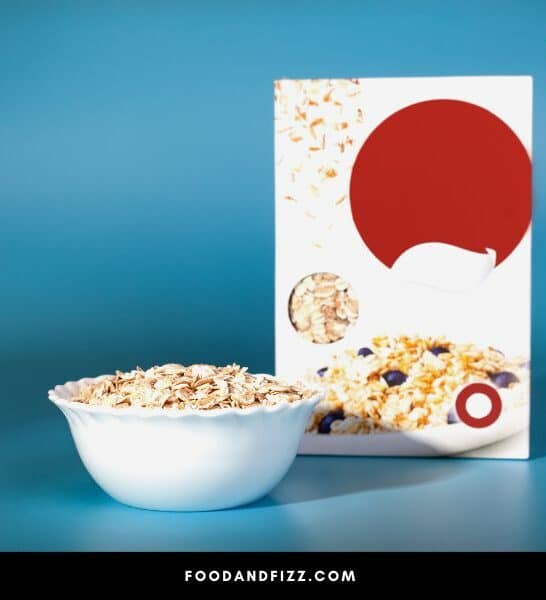A bowl of cereal is the perfect, no-effort, quick breakfast meal that is especially handy on days when you just don’t have time to cook.
But how many servings of cereal can you actually get in those cereal boxes?
How Much Cereal Is In A Box?
A box of cereal that weighs 10-12 oz contains about 11 to 12 one-cup servings in a box. Family-size boxes weighing 16-18 oz would have about 13-15 one-cup servings. The amount of cereal in a box will also be affected by what kind of cereal it is. Denser cereals may have a smaller serving size compared to lighter cereals, which may alter how many servings you can get in a box.

How Much Cereal Can I Get In One Box?
How much cereal you can get in one regular box depends on the type of cereal you have. Different brands and different types of cereal would weigh a little bit differently and thus would vary on how many servings they can yield.
For example, a 10.8 oz box of Honey Nut Cheerios yields 11 cups per box, but an 11.9 oz box of Cinnamon Toast Crunch Churros would only yield about 8 servings.
This is because they vary in density, and this affects how many servings you get in a box. Denser cereals would generally yield smaller servings.
However, on average, boxes that weigh 10-12 ounces would generate about 11-12 cups of cereal. This means that assuming you eat a cup of cereal a day, one average box will last you about 11-12 days.
Bigger, family-sized boxes would yield more servings and are in general much cheaper than smaller boxes.

How Many Ounces Are in One Serving of Cereal?
A serving of cereal usually constitutes a cup, which is roughly equivalent to 1 oz or 28 grams.
This may change depending on the type of cereal and the specific serving size indicated by the brand.
How Many Calories Are in One Cup of Cereal?
Again, this would depend on the type of cereal you have. One cup of Honey Nut Cheerios contains 140 calories while a cup of Cinnamon Toast Crunch has 170 calories. A cup of Reese’s Puffs has 160 calories and A cup of Cap’n Crunch’s Crunch Berries has about 150 calories.
You may check the table below for calories per cup of some common cereal brands.
CALORIES PER CUP OF COMMON CEREAL BRANDS
| CEREAL BRAND | CALORIES PER CUP | WITH 3/4 CUP OF 2% FAT MILK* |
| Cap'n Crunch Crunch / Berries | 150 | 252 |
| Honey Nut Cheerios | 140 | 242 |
| Cinnamon Toast Crunch | 170 | 272 |
| Cocoa Puffs | 140 | 242 |
| Reese's Puffs | 160 | 262 |
| Fruity Pebbles | 140 | 242 |
| Kellogg's Frosted Flakes | 160 | 262 |
| Kellogg's Special K Red Berries | 140 | 242 |
| Chex | 210 | 312 |
| Lucky Charms | 140 | 242 |
| Raisin Bran Crunch | 190 | 292 |
| Honey Smacks | 130 | 232 |
| Honey Bunches of Oats | 160 | 262 |
| Fruit Loops | 150 (1 1/3 cup) | 252 |
| Oreo O's | 160 (1 1/3 cup) | 262 |
| Kellog's Corn Flakes | 150 (1 1/2 cup) | 252 |
| Kashi Go Lean | 180 (1 1/4 cup) | 282 |
| *3/4 cup of 2 % Milk = 102 calories (source: | Nutritionix |
A Quick History of Cereal
The breakfast cereal is an American invention that started sometime in the mid to late 19th century. Its origin is a bit unexpected; and just like most things, it gradually evolved over time into something that is quite different from the original, both in form and in purpose.
How did it all start?
Cereal Started At A Health Spa
It all started with a man named James Caleb Jackson, who took over running a mineral spa or health resort in western New York that later came to be known as “The Jackson Sanitorium”.
The resort was extremely popular for its water cures as it was built around natural springs which were believed to have healing properties, and it became one of the largest in the world during that time.
Jackson, a deeply religious man, and a vegetarian, believed that apart from water cures, diet played an integral role in the healing process.
He believed that following a vegetarian diet consisting of fruits and vegetables and eliminating things like red meat, alcohol, coffee, tobacco, and processed foods, cured ailments both physical and spiritual.
This was back when the temperance movement and worldview were pretty dominant in the country, which essentially consisted of limiting or banning certain indulgences that endangered one’s salvation.
This lead him to experiment with other types of food and it was through this that he created the very first breakfast cereal, called Granula, in 1863.
Granula is not the same as granola and instead consisted of graham flour dough that was baked into sheets, dried and broken up into smaller nugget shapes. It was so hard and tough that it required overnight soaking before it could be eaten!
Imagine how far cereal has come from needing to be soaked overnight for it to be palatable to a convenient, under-a-minute meal.
The Kellog Brothers
Granola was actually invented by a man called John Harvey Kellogg, who took Jackson’s idea, and experimented with different ingredients like wheat and refined the process to come up with a product that was flakier and more palatable than the original version.
Also a religious man and also a prominent figure at a health resort, this time in Battle Creek, Michigan, Kellogg eventually came up with and launched the Cornflakes brand in 1895. Many competing companies then popped up and the cereal industry was born.
He worked with his brother, William K. Kellog, for several years until eventually William H. Kellog went off on his own and established the Kellogg Toasted Corn Flake Company.

No More Healthy Cereal
William H. Kellogg did away with the healthy food concept of cereal and transformed the product into something that had mass taste appeal, through advertising and marketing. Eventually, cereal came to be associated with sweet, sugary indulgence, quite far removed from its original purpose and intent.
Another Notable Name
Another man by the name of Charles H. Post, who was a patient at Kellog’s sanitarium, played a role in the growth of the cereal industry.
Upon his release from the sanitarium, he invented Grape-nuts, and his company, along with William Kellog’s, grew in the next several decades and became one of the major innovators of the cereal industry. Because of the two men, Battle Creek, Michigan came to be known as the “Cereal Capital of the World”.
For a time after that, cereal was known as an unhealthy, sweet, sugary indulgence but in the last few decades, efforts have been made to bring it back to its healthy roots.
Today, there are many options on the market that cater to different tastes and health requirements, so not only is cereal convenient, it can be healthy, too.
Is Cereal Healthy?
Cereal can be really unhealthy because of the sugar content and empty calories, but it can be healthy, too. It just depends on the type and brand of cereal, and how you prepare it.
For example, if you choose a healthy breakfast cereal but make it indulgent by adding lots of extra sugar and added fat to it, then it kind of defeats the purpose of having healthy cereal, to begin with.
What is important here is choosing the right type of cereal by reading ingredient and nutrition labels, and then preparing it in the healthiest way possible.
How To Choose the Healthiest Cereal
To be able to choose a healthy box of cereal, it is important to always check the ingredients and nutritional labels.
Below are some tips to remember to help you choose the right kind.
Whole Grain
Whole grain ingredients have more beneficial vitamins and minerals intact compared to refined grains, which makes it the healthier choice. Check the ingredient list for ingredients like “whole wheat flour, “whole grain rice” or “whole grain oats”.

Lots of Fiber
Fiber is important in helping us feel full and helps keep our digestive systems healthy. It also helps slow down the absorption of sugar in the blood stream, which makes having enough of it important in our diets.
Experts recommend choosing a cereal that has at least 3 grams of fiber per serving, but it is even better if you can find one that has 4 or 5 grams or more.
Sugar Content
According to Tufts University Frances Stern Nutrition Center, it is wise to choose a breakfast cereal that does not contain more than 4-6 grams of sugar per serving, which is equivalent to less than 2 teaspoons of sugar.
Too much sugar can cause a host of health problems and can cause weight gain, that is why it is important to regulate our intake of it.

Check the Ingredient List
The first few ingredients in the ingredient list will tell you what the cereal is mostly made of. Make sure the first few ingredients aren’t sugar or any of its derivatives like corn syrup or dextrose. If it does, move on to a different brand. Also, check for things like preservatives and artificial colorings.
Serving Size
Nutrition labels are important because they tell us the nutritional component of the cereal per serving. Depending on the type of cereal, this serving size will vary.
Lighter cereals will probably have bigger serving sizes compared to denser ones. To avoid consuming more than what we should, it is important to keep the serving size and nutritional components in mind so we can use them to suit our specific requirements.
While cereal is generally believed to be unhealthy, healthy cereals do exist and they can be part of a healthy lifestyle. It is important to just choose the right brand and be mindful of the ingredients and the specific serving sizes to ensure that we aren’t unnecessarily consuming more than what we should.
Frequently Asked Questions to How Much Cereal Is In A Box?
What Is Considered 1 Serving of Cereal?
A serving would depend on the type of cereal but on average, this is usually anywhere from ¾ cup to 1 ½ cups.
How Much Cereal Should You Have For Breakfast?
The recommended serving size for cereal for adults is around 1-1.5 oz or 30-45 grams, while for children it is ¾ oz to 1 oz or 25-30 grams.
Is it Okay to Eat Cereal Every Morning?
If you choose the right type of cereal made up of whole grains and wholesome ingredients, with enough fiber and not too much sugar, it can be a healthy breakfast choice.
Conclusion to How Much Cereal is In A Box
On average, regular cereal boxes that weigh 10-12 ounces contain about 11-12 cups or servings, while bigger boxes of 16-18 oz contain 13-15 cups or servings. Serving size depends on the type of cereal. Usually, a serving constitutes a cup, but depending on how dense or light the cereal is, the serving size can be less or more. For an accurate reading of nutritional labels and to prevent overconsumption, it is important to be mindful of the serving sizes as indicated on the label.

